

The halo effect, and other managerial delusions. Companies cannot achieve superior and lasting business performance simply by following a specific set of steps.
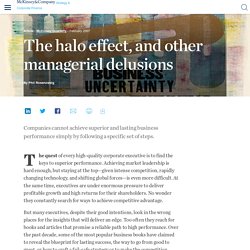
The quest of every high-quality corporate executive is to find the keys to superior performance. Achieving market leadership is hard enough, but staying at the top—given intense competition, rapidly changing technology, and shifting global forces—is even more difficult. At the same time, executives are under enormous pressure to deliver profitable growth and high returns for their shareholders.
No wonder they constantly search for ways to achieve competitive advantage.
Book reviews and related blogs/publications. Introduction and Chapter One - What is Strategic Foresight? Chapter Two - Strategic Foresight. Chapter Three Thinking about Thinking. Chapter Four The Future is a foreign country. Chapter Five Preparing for the Future. Chapter Six Mapping and Exploration of the Systems.
Chapter Seven Systems thinking. Chapter Eight Exploring different paradigms. Chapter Nine Learning from the Future & engaging in change. Case studies - good and bad.
Strategic Foresight: Learning from the Future. New book Strategic Foresight by Patricia Lustig from Stroud helps firms look to the future. ‘Situational Futuring’ and 44 Mind-Stretching Scenarios to Learn How to Use It. New business models. Report Summary Despite continued uncertain economic conditions, most companies remain persuaded that there is a strong causal link between their financial performance over a 5-10 year time horizon and their current commitment to improving their environmental, social and governance performance.
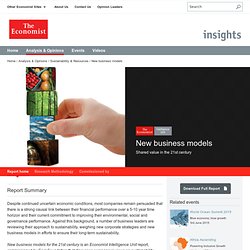
Against this background, a number of business leaders are reviewing their approach to sustainability, weighing new corporate strategies and new business models in efforts to ensure their long-term sustainability. New business models for the 21st century is an Economist Intelligence Unit report, commissioned by Enel Foundation that discusses companies’ views on sustainability measures, the challenge of measuring and reporting sustainability outcomes, and the prospects of business models focussing on long-term sustainability. Why read this report Ernst Ligteringen, CEO, Global Reporting Initiative Contributors Published:October 13th 2014. Wanted: flexible corporate strategies for fast times. Middle age catches up with StanChart. How to see into the future.
The Learning Myth: Why I'll Never Tell My Son He's Smart My 5-year-old son has just started reading.
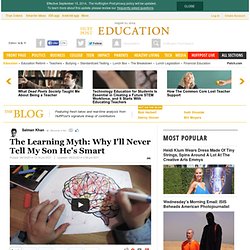
Every night, we lay on his bed and he reads a short book to me. Inevitably, he'll hit a word that he has trouble with: last night the word was "gratefully. " He eventually got it after a fairly painful minute. He then said, "Dad, aren't you glad how I struggled with that word? I think I could feel my brain growing. " 25th Anniversary series: Introduction – The Importance of Strategic Foresight: use it or lose it.
This is an extract from Strategic Foresight: Learning from the Future, by SAMI Associate Patricia Lustig, to be published by Triarchy Press in July .
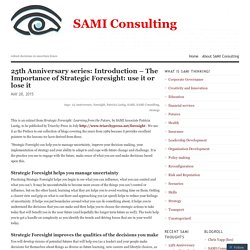
We use it as the Preface to our collection of blogs covering the years from 1989 because it provides excellent pointers to the lessons we have derived from these. “Strategic Foresight can help you to manage uncertainty, improve your decision-making, your implementation of strategy and your ability to adapt to and cope with future change and challenge. It is the practice you use to engage with the future, make sense of what you see and make decisions based upon this.
Strategic Foresight helps you manage uncertainty. Futures and Frame Games … 2. The future holds meaning for us.
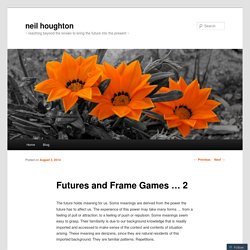
Some meanings are derived from the power the future has to affect us. The experience of this power may take many forms … from a feeling of pull or attraction; to a feeling of push or repulsion. Some meanings seem easy to grasp. 10 TRENDS FOR 2015. Jeff Bezos recently told shareholders that Amazon would have 10,000 Kiva robots by the end of 2014 (from just 1,400 in 2013), and that this could cut fulfillment costs for an average order by 20-40% (BCG, August 2014).
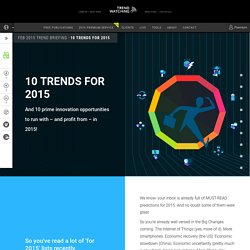
And while lower costs will be central to the robot narrative told in boardrooms during 2015, smart business will be planning not just how robots might decrease their costs, but how they can also increase customer satisfaction, too. Draw inspiration from the examples below around how to use robots to initiate better customer service: more reliable, faster, richer, more personal, more convenient … the list goes on.
Remember, this isn't about Man vs. Machine. Inside The World's Most Intriguing (And Probably Only) Futurist Bar. Strategic Foresight and Innovation - OCAD University - 2014. How the Internet of Things Changes Business Models - Gordon Hui. By Gordon Hui | 12:00 PM July 29, 2014 As the Internet of Things (IoT) spreads, the implications for business model innovation are huge.
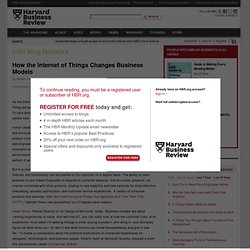
Filling out well-known frameworks and streamlining established business models won’t be enough. To take advantage of new, cloud-based opportunities, today’s companies will need to fundamentally rethink their orthodoxies about value creation and value capture. Value creation, which involves performing activities that increase the value of a company’s offering and encourage customer willingness to pay, is the heart of any business model. In traditional product companies, creating value meant identifying enduring customer needs and manufacturing well-engineered solutions. But in a connected world, products are no longer one-and-done. Albert Shum, Partner Director of UX Design at Microsoft, notes: “Business models are about creating experiences of value. Options for control points also expand through the IoT. What Would Peter Drucker Advise Second-Acters? Bubble Finance At Work: How The Share Repurchase Mania Is Gutting Growth And Leaving Financial Wrecks Like Radio Shack.
Janet Yellen is a chatterbox of numbers, but most of them are “noise”.
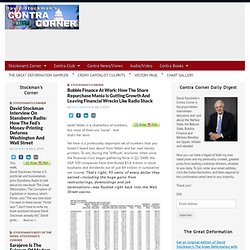
And that’s her term. Yet here is a profoundly important set of numbers that you haven’t heard boo about from Yellen and her mad money printers. To wit, during the “difficult” economic times since the financial crisis began gathering force in Q1 2008, the S&P 500 companies have distributed $3.8 trillion in stock buybacks and dividends out of just $4 trillion in cumulative net income. Association of Professional Futurists - Nine Metaphors for a Futurist. Initially this post was to be called 'Dress Code for Futurists'.
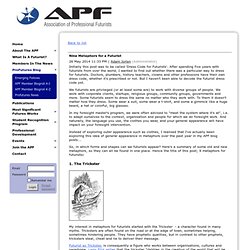
After spending five years with futurists from over the world, I wanted to find out whether there was a particular way to dress for futurists. Doctors, plumbers, history teachers, clowns and other professions have their own dress code, whether it's prescribed or not. But I haven't been able to decode the futurist dress code yet. We futurists are privileged (or at least some are) to work with diverse groups of people. We work with corporate clients, startups, religious groups, community groups, governments and more. The Hames Report. We are responsible not only for what we do but also for what we could have prevented Peter Singer - Ethicist Leaders across the world, young and old, men and women, in every sector of society, are encountering a moral dilemma that is fundamentally different from the many ethical dilemmas they face every day of the week.
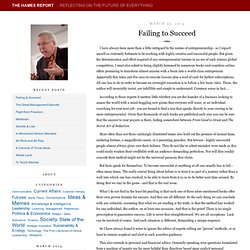
Prelude 2. Speculative Futures. In the last post I provided a prelude to speculative futures. I presented one point of departure and I continue this project here through another trajectory that is informed by Liam Sprod’s 2012 book Nuclear Futures. Liam Sprod’s (2012) Nuclear Futurism engages with apocalyptic imagery associated with ecological collapse and nuclear Armageddon. Although clearly concerned with the future of humanity, it is important to note that when Sprod writes “[t]he future is exactly what is at stake in the discourse of nuclear futurism” (p. 74), he is not only referring to the future of the world, but also to the future of the notion of the future itself.
The future-in-itself is also an object of inquiry, and Sprod emphasises the “importance of a rigorous metaphysics, of both temporality and ontology … open[s] up the space of a possible escape from the apocalyptic present” (p. 61). In contrast, Sprod argues for a shift to the ‘future perfect’ that involves two moves. Smashing Three Myths About Strategic Thinking. It's often said that every leader needs to think strategically. But what does thinking strategically mean exactly? Nick Tasler, the CEO of consulting firm Decision Pulse, says that strategic thinking is about managing what to do and what not to do.
"At the highest level, this usually means deciding to sell off one company in order to buy another one. More often it simply means deciding to move some initiatives to the back burner in order to concentrate the bulk of your resources in a single key area," Tasler writes in Harvard Business Review. But faced with enormous amounts of information and decisions, leaders can confuse strategy with productivity, or spend too much time thinking without taking action. The Thing From The Future – Situation Lab - OCADU. The Thing From The Future is an award-winning imagination game that challenges players to collaboratively and competitively describe objects from a range of alternative futures.
*link fixed The object of the game is to come up with the most entertaining and thought-provoking descriptions of hypothetical objects from different near-, medium-, and long-term futures. Each round, players collectively generate a creative prompt by playing a card game. How resource scarcity is driving the third Industrial Revolution. Will shortages of energy, materials, food, and water put the brakes on global growth? Far from it. By combining information technology with industrial technology, as well as through harnessing materials science and biotechnology, innovators are showing that it is possible to produce more with less and to access resources at far lower costs. Spectacular "Supersociety" Possible Thanks to Highly-Human Shift? Flash Foresights from Daniel Burrus.
Leverage cover - meadows_1999.pdf. How Being Really Bad Is Really Great For Business.